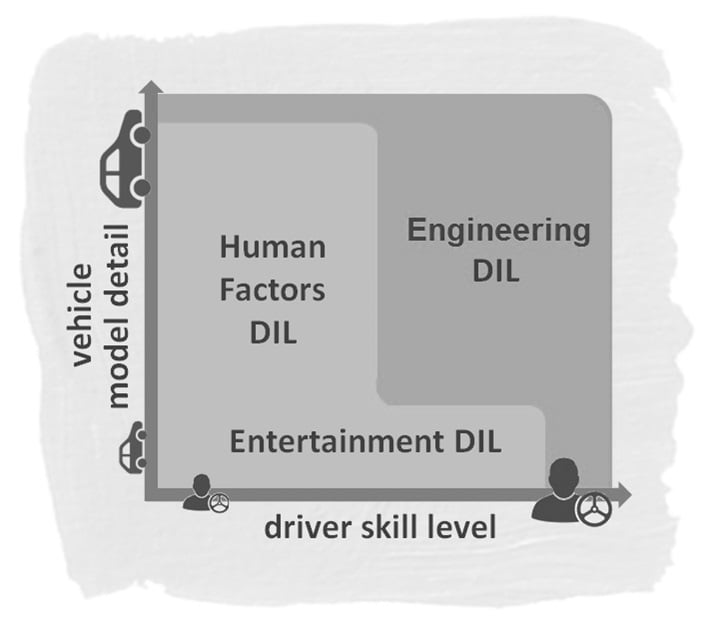There is a broad spectrum of Driver-in-the-Loop (DIL) simulators in use in the world today – Ranging from low cost gaming-oriented devices to multi-million dollar simulators that can fill up an entire room. If we are interested in DIL simulators for their potential to assist with particular areas of vehicle development or driver assessment, we might be interested in certain types of simulators, but not others. For example, if our interest is in finding a tool primarily to help develop Electric Power Assisted Steering (EPAS) or Electronic Stability Control (ESC) systems, we may find that certain types of DIL simulators are better suited due to the technology employed or fundamental performance capabilities.
If we are hoping to find a suitable DIL simulator technology pathway from amongst the many seemingly attractive possibilities, we may scratch our heads a bit, wondering where to start and what to query. One way to begin our quest is to categorize DIL simulators based on their features, performance, and benefits, and see if these classifications can help us align a particular type of simulator with our needs.
1) Entertainment DIL
Within this category of driving simulators are products ranging from retail desktop and gaming systems to commercial-grade installations used in amusement parks, trade shows, and other events. These simulators feature graphics-based software to create a simulated driving environment and, at the commercial end of the range, can include mock-up vehicle cockpits, motion systems, and audio systems. Entertainment DIL simulators do not typically connect to sophisticated vehicle simulation tools, and therefore do not typically meet the requirements for automotive engineering. However these simulators are often endorsed by professional drivers, as they can be useful tools for learning and practicing driving patterns on visually-realistic race tracks and so on.
2) Human Factors DIL
While Entertainment DIL simulators are purposed primarily towards challenging players’ driving skills, Human Factors DIL simulators are designed to more closely simulate the actual driving conditions of real vehicles, and are often used to measure the physiological responses and behaviors of human drivers. The additional requirements to make this happen takes driving simulation to another level, one where sophisticated computers, motion systems, and vision systems come into play in order to create virtual driving scenarios that simulate real world situations. Human Factors DIL simulators require additional complexity, and some of these simulators can have extremely large footprints and cost into the hundreds of millions of dollars.
Human Factors DIL simulators that include motion typically utilize hexapod motion bases. Hexapods have been used in flight simulators in the aviation industry since the 1960s; later they were embraced by the automotive industry as a way to test ground vehicle designs. The hexapod provides motion with six degrees of freedom (6DOF) – vertical, surge, sway, pitch, yaw, and roll – by means of six actuators controlled by conventional software. However, when constructed in medium scale or larger, hexapod machines inherently introduce mechanical lag and friction, so the usefulness of these machines for automotive simulation is typically limited to events and scenarios for drivers who are below the expert or professional skill level.
3) Engineering DIL
These simulators represent the newest, emerging class of DIL simulation tools. Like Human Factors DIL simulators, they are designed to closely simulate actual driving conditions of real vehicles, and as such, they are useful for vehicle manufacturers’ engineering and product development work. However, unlike Human Factors DIL simulators, the emphasis for Engineering DIL simulators is typically directed towards measuring vehicle and driver performance rather than monitoring driver behaviours.
Engineering DIL simulators can be described as “form follows function” simulators. For example, they are typically designed as lightweight machines with medium size form factors. Identifying features might include the use of structural composites in the cabin and cockpit mock-ups, non-hexapod actuator and motor arrangements such as stratiform machines, sophisticated photo-realistic graphics projected onto large free-standing screens, and – less obvious upon visual inspection – powerful software and control strategies that emphasize minimized latency and application synchronization.
Aligning DIL simulators with Use Cases
As with any other technology investment, a DIL simulator can be valued in a number of different ways. Vehicle constructors, for example, might define a DIL simulator’s value strictly in terms of its ability to affect the vehicle development process, with the hope being that use of such a tool improves the efficiency of physical prototype testing in some measurable way. In such cases, we can take on board the above-described types of simulators and attempt to align them with specific areas of product development. If we do this, we might develop a basic map such as the one shown here.
If we can relate a map such as this to specific tests and simulations that are required for vehicle development, we can assess whether or not a particular type of DIL simulator is appropriate, or even assign different types of simulators to different vehicle development areas. For example, the aforementioned EPAS and ESC system developments would require sophisticated vehicle physics models as well as subjective feedback from expert driving evaluators. In such a case a Engineering DIL simulator would be the tool of choice rather than a Human Factors DIL or Entertainment DIL simulator. In a corollary sense, we might deduce that the reason why Engineering DIL simulators have come into existence in recent years has been to fill a product development toolset void. This is indeed the case.
To learn more about the three main types of driving simulators, download our FREE eBook, Looking down the road: Harnessing the benefits of driving simulator technology.












